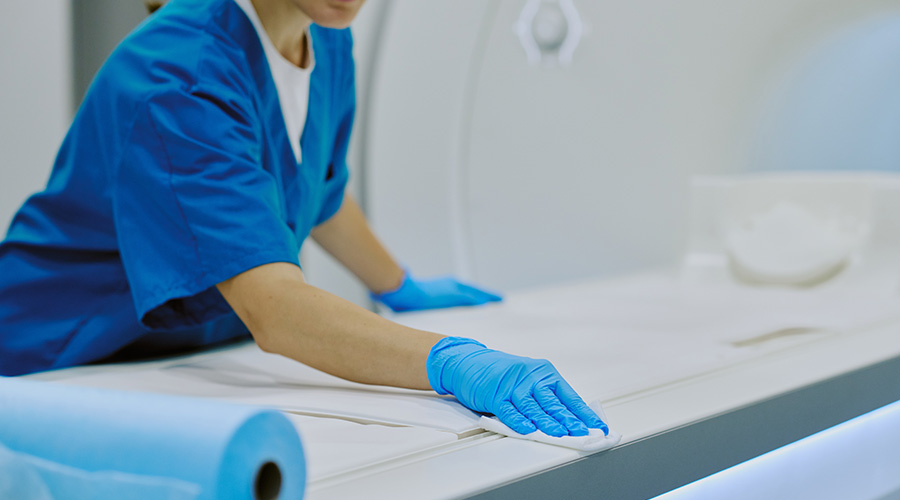The emergence of novel outbreaks such as the COVID-19 Coronavirus reveals the magnitude of pandemic response efforts that are required, and the tremendous need for reliance on new technologies. In particular, rapid diagnostics have been spotlighted by the CDC and the U.S. government as essential to the nation’s ability to manage this deadly infectious disease as it gains a widespread foothold across the states.
Outbreak management, particularly with highly virulent infections like COVID-19 that spread easily through respiratory transmission, requires a two-part approach – first identifying which patients actually have the infection and then tracking the spread of the infection across different regions and states. Diagnostics and surveillance technologies have advanced tremendously over the years and are contributing to the fast action the U.S. has taken in recent weeks; yet there are still parts of the process that can be improved to help us minimize the risks even more.
Diagnostics: the key tool for outbreak detection
Before outbreaks can be managed, it’s important to pinpoint which patients are infected and who has been exposed to the virus or bacteria through those individuals in order to determine where it may spread to next. This is where whole genome sequencing (WGS) diagnostic tools provide the most value.
WGS diagnostics identify disease causing variants using sequences from bacterial, viral, and fungal pathogen genomes. These technologies have evolved over the last ten years to become even more precise with their detection, and minimize the time needed to provide testing results, delivering key data in hours instead of days. In pandemic situations where viruses and bacteria spread quickly, reducing the time between testing and targeted therapy can drastically improve patient outcomes and ensure clinicians have the information they need to diagnose and treat patients.
Challenges with access to diagnostic tests
While the development of these technologies has advanced, challenges remain with getting diagnostic tools in the hands of long-term care facilities, hospitals, and other areas where patients are at a higher risk.
The rigorous FDA approvals process
With the recent COVID-19 outbreak we saw the CDC set forth guidelines and pushed a coronavirus test through FDA-issued Emergency Use Authorization in a matter of days. While it’s an impressive feat for this specific outbreak, there are many other diagnostic technologies designed to address other concerning outbreaks such as drug resistant UTIs, C. auris and other infections, that are held up in the FDA submission process. This process can take months or years, leaving many potentially life-saving technologies in pilot project limbo until approval is provided.
The limited number of test sites
At the outset of novel outbreaks, only a limited number of facilities are equipped to manage testing efforts. With coronavirus, initially only four sites were able to test samples, leaving hospitals and care facilities on the frontlines with no choice but to send their samples elsewhere and await test results. Inability to test at point of care onsite or in some cases, even within the state, can delay infection identification and treatment. What’s more, in a fast-moving outbreak like COVID-19, the limited number of authorized testing facilities can result in a backlog of samples and long delays for results to be delivered.
Government hold-ups with testing kit supplies
In an outbreak, the FDA and CDC are tasked with ensuring the private and public sectors are equipped with enough test kits and have introduced a framework that can be used to replicate approved test kit development. As noted in a recent senate committee hearing on the coronavirus management plan, faulty tests developed by the CDC have created delays in getting states with reported cases the amount of test kits they believe they will need to ensure individuals suspected of having the infection are properly tested. The CDC and FDA both claim that they will be able to ramp up production to meet these demands, but legislators are skeptical, creating concern over whether healthcare facilities will be properly equipped to gather samples.
The bottlenecks with securing diagnostic tools primarily come from a regulatory side but as these technologies continue to evolve, it is envisioned that the government would improve its practice and is able to identify and push these tools through faster.
Monitoring and surveilling the progression of an outbreak
Diagnostic testing identifies who is infected but to manage an outbreak, we must also look at these infections with a wider lens to evaluate where and how it’s spreading - which is where surveillance comes in. Cloud-based software solutions provide unified platforms where data from diagnostic tests can be gathered. Once diagnostic information is collected, these databases can analyze genotype and phenotype data from thousands of clinical isolates, collected in real-time from facilities testing for outbreak cases, regardless of their location and proximity to one another.
Cloud-based surveillance provides valuable insights on how individual infections turn into transmission events, giving hospitals and healthcare facilities the tools to improve infection control protocols. These platforms are also capable of pulling diagnostic information from individual patients, comparing it to population data and making decisions based on outcomes from other similar cases.
Outbreak management for pandemics like COVID-19 Coronavirus is improving; we’ve seen diagnostics take center stage as the key tool for evaluating the patient. To continue our momentum in outbreak management and better track these infections, we need to see regulatory agencies improve access to diagnostic tools and broader use of collaborative surveillance technologies. Making these improvements, even after fears of the coronavirus subside, will be a necessary step in mitigating future and current outbreak threats.
Oliver Schacht, PhD, is the CEO of OpGen.

 Hand, Foot and Mouth Disease on the Rise
Hand, Foot and Mouth Disease on the Rise BayCare Reveals Pagidipati Children's Hospital at St. Joseph's
BayCare Reveals Pagidipati Children's Hospital at St. Joseph's Preparing for the Hazards of Winter Weather
Preparing for the Hazards of Winter Weather Why Identity Governance Is Becoming a Facilities Management Issue
Why Identity Governance Is Becoming a Facilities Management Issue Habitat Health Opens South Los Angeles PACE Center
Habitat Health Opens South Los Angeles PACE Center